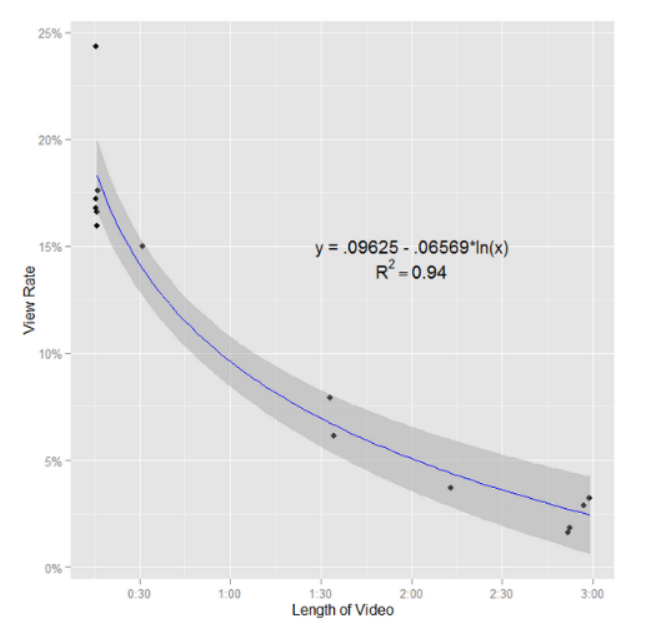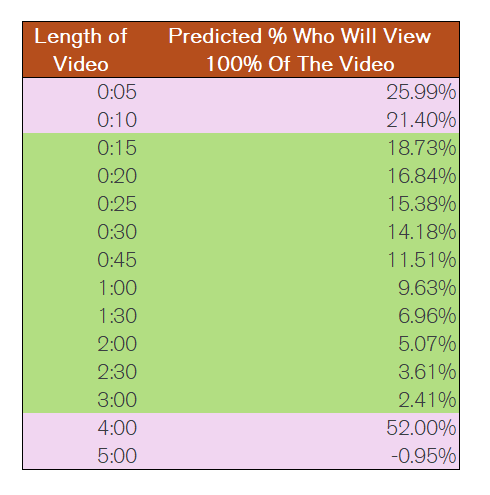Our Hypothesis
Shorter YouTube video ads have higher view rates and cost less per view.
Test Procedure
Look at actual YouTube video ad performance data on view rates to 100% and cost per view to determine the ideal YouTube video ad length. If our hypothesis is true, we also want to know what equation approximates the relationship between:
- View rates and length and
- Cost per view and length
Planned Takeaway From Test Results
We’ll discover the optimal YouTube video length for ads in order to most effectively advertise online, while optimizing performance and control costs.
The Data
We looked at five client’s Trueview ad data in May 2014. These clients were running 14 videos as ads with multiple ad formats per ad, but most volume was Trueview in-stream as this format is the most common. There was some in-display volume. The targeting methods varied (contextual, remarketing, etc.). These clients are in vastly different industries with different seasonality and have spent over $30k in May on YouTube ads. The data set is diverse and can be used for broader insights.
View Rates
Each dot represents a video, which a specific length and view to 100% rate. We removed one ad which was over 21 minutes (2% view rate) as it threw off the X-axis of the graph. A log equation best represents the drop-off.

The equation we derived is Y= 0.09625 – 0.06569*ln(X), where X is measured in minutes. So for a thirty second video, X=0.5 and we predict that 18.73% of people would watch 100% of the video. I’d like to say thanks to Matt McAnear for double checking and perfecting the regression.
In this graph, there’s a conspicuous gap in 50-70 second range, which is found to be a common video length. We didn’t have any clients testing videos of this length in May 2014, but we have had a few minute-ish long videos in the past.
- We had a 0:52 video get a 10% view rate. The predicted view rate for a 0:52 long video ad would be 10.57% using this equation.
- Another client had a 1:11 long video get an 8% view rate. The predicted view rate for a 1:11 video ad is 8.52% using this equation..
The model is coming pretty close to actual performance within the relevant prediction range of 0:15 to 3:00 minutes. The coefficient of determination is fairly high at 0.94. This means that 94% of the view rate can be predicted by length.
The model can predict video view rates from about 0:15 to 3:00 minutes, which is the relevant range of data we have. The model is inaccurate outside of the 0:15 to 3:00 range. As you can see it predicts a negative rate for a 5 minute video (not possible) and users can’t skip a TrueView instream ad until they watch 5 seconds, so the view rate at 0:05 will be much higher than 26%.

Are Shorter Videos Cheaper?
Yes, but we can’t predict how much cheaper. Google’s quality measure does appear to be awarding shorter videos. The data doesn’t lend itself to a neat regression as the view rate did, but here’s what we saw for the three clients we evaluated with multiple videos.

All clients saw substantial increases in cost per view by using longer videos. Our client with a video of over 21 minutes – it’s cost per view was $0.59 (much higher than anything here).
Hypothesis Test Results
So, how long should a Youtube advertisement be?
Longer video ads are less likely to be viewed to 100%. For video ads 0:15 to 3:00 long, the equation Y= 0.09625 – 0.06569*ln(X) predicts view rates fairly accurately. We have lots of data saying that shorter videos also cost less, but do not have statistical significance or a reliable equation that can describe how much less with certainty.
How Can We Use This Data?
Use these numbers as rough guidelines when deciding how long to make videos. For every few additional seconds of content, think about if that content sufficiently improves the experience to be worth the drop off in views and the additional cost per view you’ll be paying. The chart above and the equation Y= 0.09625 – 0.06569*ln(X) can describe the drop off in view rates fairly accurately.
Got any questions or thoughts? Post ‘em in the comments below!
Looking for more info about video optimization, video advertising, or understanding the ROI of these efforts? Don’t worry, we got your back. Check out the Seer YouTube Video Marketing Guide.


